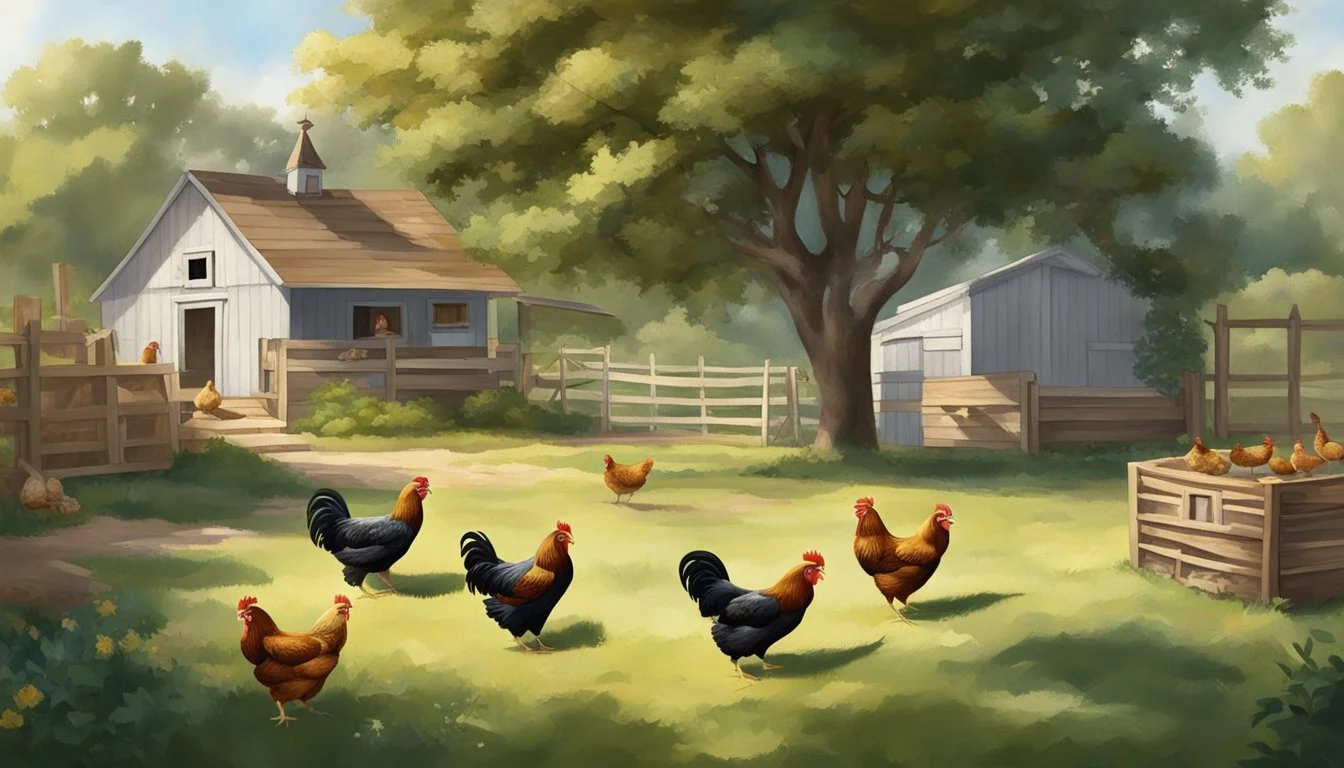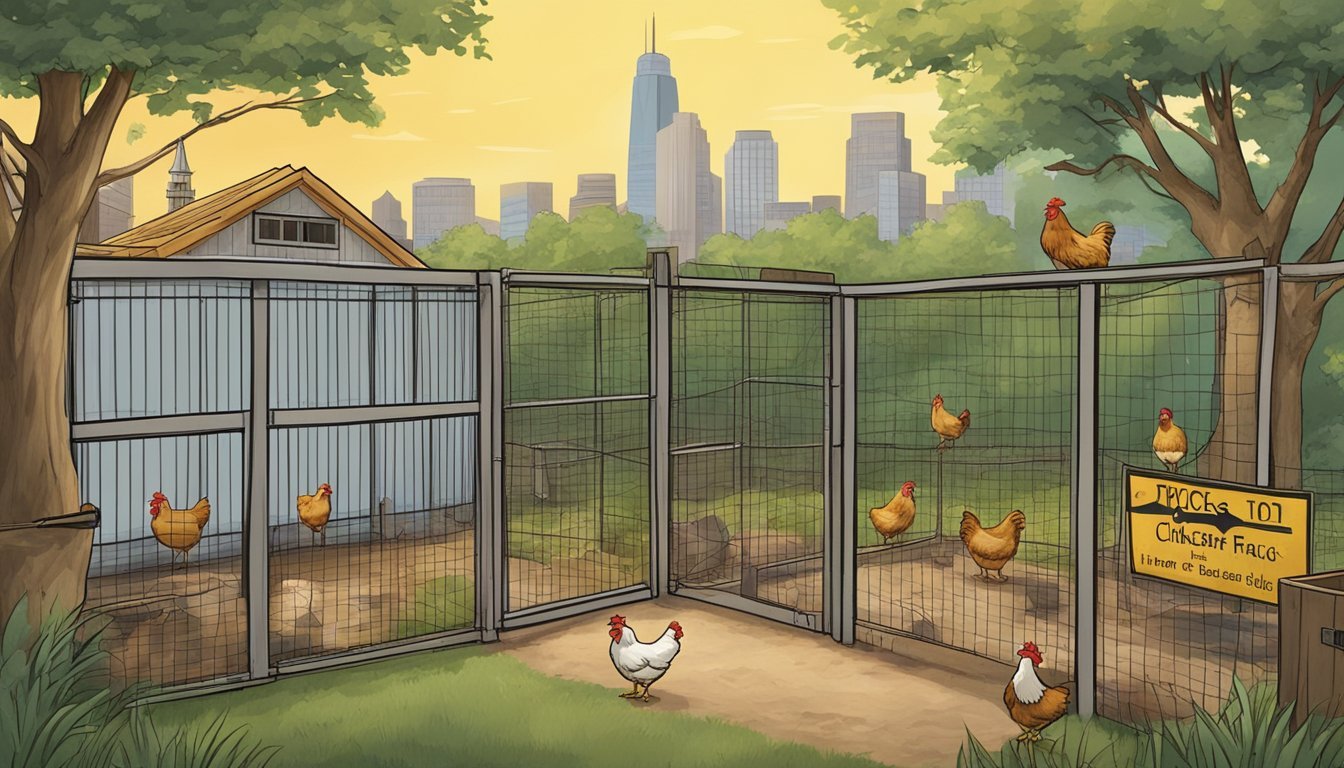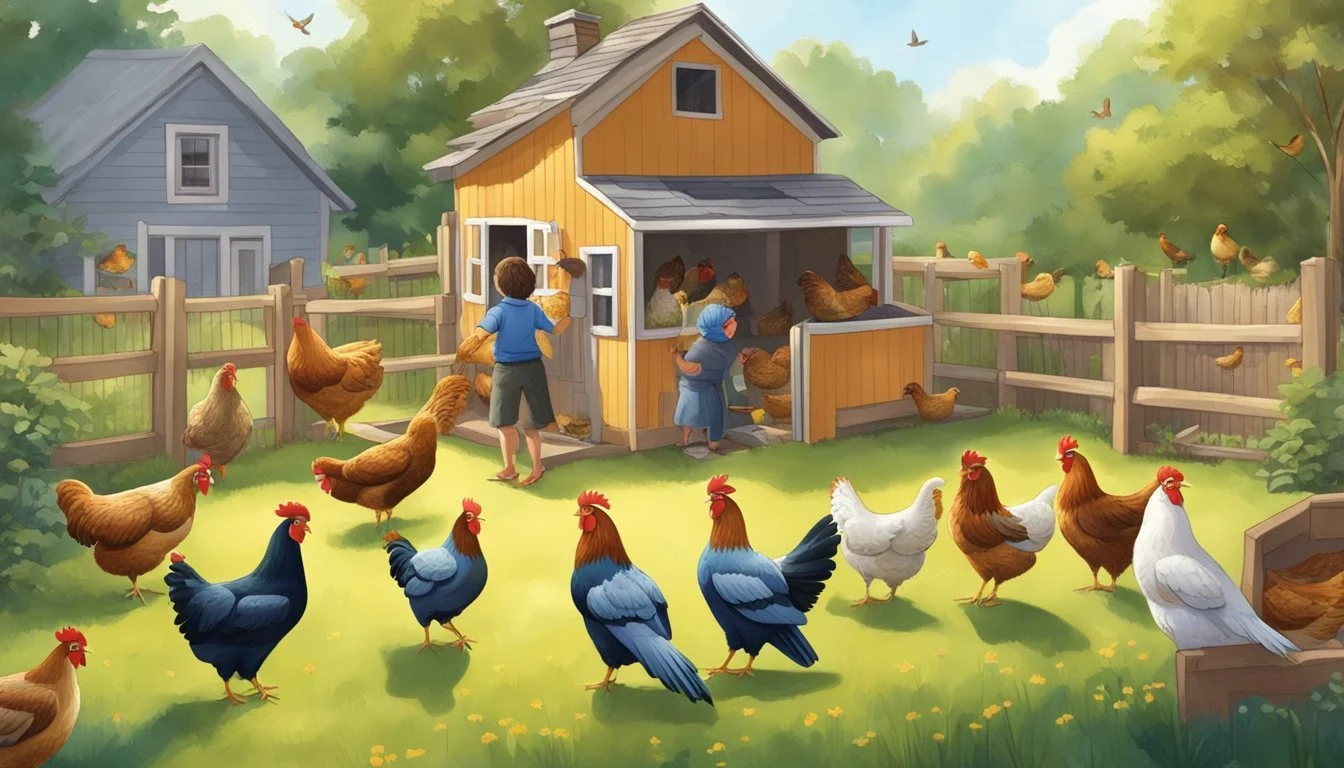Keeping Backyard Chickens in Rochester, NY
Essential Guidelines for Urban Poultry Farming
Residents of Rochester, NY have taken an interest in sustainable living and local food movements, which has led many to consider backyard chicken keeping. This practice allows individuals to produce their own eggs and, in some cases, meat. It also provides an opportunity for hands-on education about animal care and food sources for families.
The City of Rochester has established ordinances to regulate the keeping of backyard chickens to balance this trend with neighborhood harmony and public health. Enthusiasts looking to join the community of backyard poultry keepers must navigate local laws to ensure they are compliant. For instance, while Rochester allows the keeping of chickens, details such as space requirements per chicken and potential limitations on the number of birds must be followed.
Obtaining a license for backyard chicken keeping is mandatory, and such permission comes with its own set of rules and guidelines. This includes restrictions on the keeping of roosters due to noise concerns and zoning regulations pertaining to the amount of space needed for the chickens. Keeping backyard chickens in Rochester can be a rewarding experience, but it requires a clear understanding of and adherence to the city's specific requirements.
Understanding Local Chicken Laws
Knowing the specific regulations that guide keeping backyard chickens in Rochester is crucial. Rochester, New York has its own set of rules which residents must adhere to for urban chicken farming, encompassing zoning, permits, and neighborhood considerations.
Zoning Restrictions and Legal Provisions
In Rochester, there are definite zoning ordinances stipulating where chickens can be raised. Residents must ensure their property is zoned appropriately for keeping chickens. Rochester's laws affirm that chickens are permissible as pets under Chapter 30, section 19, but they must meet proper space requirements. Specifically, each chicken must be provided with at least four square feet of space. Additionally, chicken coops and structures must comply with local zoning laws regarding placement and size.
Permit and License Requirements
A key legal requirement for keeping chickens in Rochester is the acquisition of a license. One must obtain a license from the Chief of Police before they start raising backyard chickens. This helps ensure that the presence of the chickens does not conflict with the well-being of the community. The municipality may limit the number of chickens to 30 fowl, contingent on the amount of available open space, with a prescribed minimum of 240 square feet for an open area.
Table: Checklist for Chicken Keeping in Rochester
Requirement Detail Space per chicken At least 4 square feet License Required, obtain from the Chief of Police Maximum number of chickens 30 fowl (if adequate space is provided) Minimum open area for 30 chickens 240 square feet
Nuisance and Neighbor Considerations
Consideration for neighbors forms an integral aspect of the local chicken laws in Rochester. The ownership of male fowl, specifically roosters over four months of age, is prohibited within city limits to prevent noise nuisances. Chicken keepers must also be mindful of maintaining cleanliness and controlling odors to minimize nuisance complaints. It's important to maintain good relationships with neighbors by ensuring that the chickens and their living quarters do not become a source of disturbance or disagreement.
Choosing the Right Breed
When selecting the right breed of chicken for your Rochester, NY backyard, key factors include local climate compatibility, intended egg production and purpose, as well as the chickens' behavioral traits. Each breed has specific characteristics, making some more suitable than others for particular environments and needs.
Considering Climate and Environment
Rochester's climate can be challenging for backyard chickens, with cold winters and varied seasons. Hardy breeds like the Rhode Island Red and Buff Orpington are well-suited for this region, thanks to their resilience in colder weather. They have robust feathering and can maintain egg production even when temperatures drop.
Rhode Island Red: Tolerant of cold, suitable for Rochester's winter.
Buff Orpington: Thick feathering provides insulation against the cold.
Egg Production and Purpose
For enthusiasts prioritizing egg production, prolific layers such as Lohmann Browns are ideal, often yielding over 300 eggs annually. Egg color varies among breeds, adding a playful variety to your basket.
Lohmann Brown: High egg producers with over 300 eggs per year.
Ameraucana: Known for laying blue eggs, offering color diversity.
If raising chickens for both meat and eggs, dual-purpose breeds like the Brahma serve well; they provide a substantial amount of meat and respectable egg production.
Behavioral Traits
Behavioral traits are crucial for maintaining a peaceful coop. Brahmas are recognized for their calm demeanor, often keeping the flock's peace. For first-time owners, a docile breed such as the Brahma or Buff Orpington can ease the learning curve, as they are typically gentle and easy to handle.
Brahma: A gentle giant that can help maintain harmony within the flock.
Buff Orpington: Lovable and docile, good for beginners.
When constructing a chicken coop in Rochester, ensure each chicken has enough space, adhering to local ordinances which mandate a minimum of four square feet per bird. This provides sufficient room for the chickens to thrive and exhibit natural behaviors.
Designing Your Chicken Coop
When designing a chicken coop in Rochester, NY, one must balance space efficiency, predator protection, and cleaning convenience to ensure a safe and healthy environment for the backyard chickens.
Space and Floor Space Requirements
A chicken requires at least four square feet of floor space inside the coop to ensure ample living area. For Rochester residents, local ordinances allow chickens as pets, with guidelines specifying that no more than 30 chickens may occupy a 240-square-foot open area. Coop design can be optimized for small yards using vertical layouts or multi-level perches, but each chicken's space needs must be met regardless of the coop style chosen.
Minimum Indoor Space Requirements per Chicken:
Standard size: 4 square feet
Bantam size: 2 square feet
Protection Against Predators
To keep chickens safe from predators, one's coop must be thoroughly enclosed with sturdy materials. Predators can include raccoons, foxes, and birds of prey, making it essential to secure the coop with hardware wire instead of chicken wire, which is designed only for retaining chickens, not deterring predators. The coop's windows and run should be well-covered, and doors reinforced to prevent any unauthorized access.
Predator Protection Checklist:
Enclosed with 1/2" hardware wire
Secure locks on doors and windows
Coop placed at least 25 feet from dwellings (as per local ordinance)
Accessibility and Cleaning
Regular cleaning is vital for the health of backyard chickens, so coop design should factor in ease of access for maintenance purposes. Removable panels, wide doors, and an adequate height for humans to stand inside are elements that can greatly facilitate cleaning. Proper ventilation is critical to remove moisture and ammonia, so design the coop with ventilation in mind to maintain a dry and odor-free space.
Cleaning Efficiency Features:
Removable floor trays
Accessible nests and roosts
Sloped floors for drainage
Daily Care and Management
Keeping chickens in the backyard requires daily attention to ensure their health and productivity. This involves routine practices such as feeding, watering, monitoring for health issues, and handling eggs properly.
Feeding and Watering
Chickens should have constant access to fresh water and a balanced diet. Water containers must be cleaned and refilled daily to prevent the spread of diseases. As for feeding, a mix of layer pellets and grains serves as a complete feed, providing them with the necessary nutrients for good health and consistent egg production.
Water: Refill at least once daily.
Feed: Provide layer feed and occasionally supplement with grains or kitchen scraps.
Frequency: Daily feedings, monitoring for spoilage or contamination.
Health Monitoring and Veterinary Care
Monitoring the health of chickens is critical for preventing diseases. Owners should observe their chickens daily for any signs of illness, such as lethargy, abnormal droppings, or changes in eating habits. Annual check-ups with a veterinarian familiar with poultry can help manage their overall health and productivity.
Observations: Check for signs of illness each day.
Preventative Care: Keep the coop clean and provide vaccinations if recommended.
Veterinary Services: Schedule annual check-ups; consult immediately for any health concerns.
Egg Collection and Handling
Eggs should be collected at least once a day to ensure freshness and prevent breakage. After collection, they should be cleaned gently and can be stored at room temperature for several weeks. However, refrigeration extends their shelf life.
Collection Frequency: Daily.
Cleaning Eggs: Use warm water and a soft brush or cloth.
Storage: Refrigerate to prolong freshness, if desired.
Interaction with the Community
When residents of Rochester, NY choose to keep backyard chickens, they become part of a broader community interaction that includes considerations about neighborly relations and educational opportunities.
Keeping Neighbors Happy
Neighbors' contentment is key to a harmonious community. Keeping backyard chickens requires thoughtful practices to avoid any nuisance, such as:
Maintaining Cleanliness: Regular cleaning of the chicken coop to prevent odors and pests.
Noise Management: Since roosters are typically more prone to creating noise, which can be a source of nuisance, the residents often opt to keep only hens.
Visual Aesthetics: Properly maintained and visually appealing chicken coops contribute positively to the neighborhood scenery.
Respecting these practices ensures neighbors are not inconvenienced and that the chicken keeper's activities integrate smoothly into the community fabric.
Chicken Keeping as an Educational Tool
Backyard chickens offer a rich source of community-based education, providing practical learning experiences, which include:
Understanding Animal Husbandry: Residents, especially children, learn the responsibilities of caring for animals.
Learning About Food Sources: It provides insight into where eggs come from, fostering an appreciation for locally sourced food.
Community events may also focus on educating the public about the benefits and best practices of raising chickens, thereby enhancing the overall knowledge and support within the community.
Understanding Chicken Behavior
Keeping backyard chickens requires an understanding of their natural behaviors to ensure a harmonious flock. Recognizing how chickens interact and what their behaviors indicate can lead to a healthier and happier chicken community.
Social Dynamics and Pecking Order
Chicken social structure is complex, characterized by a hierarchy known as the pecking order. Hens and roosters establish their place in the flock through this order, which affects their access to food, nesting areas, and mates. Dominant chickens eat and drink first, while submissive ones wait their turn. Establishing the pecking order can involve pecking and other aggressive behaviors, but once set, it reduces overall conflict and helps maintain stability within the flock.
Top of the hierarchy: Often a rooster, if present, or a dominant hen
Bottom of the hierarchy: Typically the youngest or most submissive hen
Changes in the flock composition, such as adding new birds, can disrupt this order and may require a period of re-establishment.
Roosting Habits
Chickens have a natural instinct to roost off the ground during the night. Roosting bars provide the flock with a sense of security from predators and elements. Both hens and roosters participate in this behavior, and the pecking order often dictates roosting positions. Higher positions on the roost are generally preferred and taken by the higher-ranking chickens in the hierarchy.
Height of roosting bars: Should be between 2 to 4 feet off the ground for comfort and safety.
Material for bars: Sturdy, natural materials such as wood are ideal to support the chicken's grip.
Roosting is also a time for chickens to rest, conserve body heat, and sleep. Providing an adequate roosting environment is crucial for chicken welfare.
Preparing for Different Seasons
When raising backyard chickens in Rochester, NY, one must consider the city’s variable weather patterns. Proper seasonal preparation ensures the health and comfort of the chickens throughout the year.
Winterizing Your Coop
Insulation: The winter months in Rochester are known for their cold and snowy conditions. Insulation is key. Owners should insulate the coop without compromising ventilation, to prevent moisture buildup which can lead to frostbite.
Windows: Cover windows with plastic film to retain heat.
Roosts: Position roosts away from drafts, yet ensure they are not enclosed too tightly, as chickens' respiration needs to vent out.
Water: Water sources freeze, so a heated waterer or a water heater base is often necessary to provide chickens with unfrozen water.
Managing Heat in Summer
Ventilation: Warm and humid Rochester summers call for ample ventilation in the chicken coop. Owners should create cross-ventilation by having multiple openings, like windows or vents.
Fans: Installing fans can help maintain air circulation.
Shade and Water: Protect chickens from heat stress by ensuring constant access to shade and cool, fresh water.
Cooling Treats: On particularly hot days, they can offer chilled foods like watermelon to help chickens cool down.
Handling Common Chicken Keeping Challenges
In Rochester, NY, backyard chicken keepers may encounter several challenges, particularly with predators and pests, as well as noise and odor issues. Addressing these concerns effectively ensures a healthy environment for the chickens and maintains good relations with neighbors.
Dealing with Predators and Pests
Predators pose a significant threat to backyard chickens in Rochester. To protect poultry, owners should invest in sturdy coops and reinforce them with hardware cloth instead of chicken wire, which can deter predators such as raccoons, foxes, and hawks. It's critical to secure the coop, especially at night, and consider installing motion-activated lights or alarms that can scare away potential intruders.
Preventing pests like rodents requires maintaining a clean environment. Feed should be stored in metal bins with tight-fitting lids to avoid attracting pests. Regularly cleaning the coop and properly disposing of waste can significantly reduce the presence of pests.
Addressing Noise and Odor Issues
Noise can be a nuisance to neighbors, and while hens are generally quieter than roosters, they still generate sound, particularly during egg-laying. Mitigating noise involves strategic placement of the coop away from property lines and incorporating sound-absorbing materials like straw or wood chips.
Odor management is key in an urban setting like Rochester. Keeping the coop clean is essential; frequent changing of bedding and proper ventilation will help control odors. Composting chicken waste properly can also reduce smell and provide excellent fertilizer for gardens.
Legal and Ethical Considerations
When keeping backyard chickens in Rochester, NY, residents must adhere to specific legal requirements and uphold ethical standards to ensure the welfare of the chickens and community harmony.
Compliance with State Regulations
The City of Rochester, NY mandates licensing for residents who wish to keep backyard chickens. It is incumbent upon individuals to obtain a license from the Chief of Police. As for the number of chickens, one is allowed to have up to 30 fowl. However, properties must provide at least 240 square feet of open area for these chickens. A critical part of the ordinance is the prohibition of roosters; male fowl over four months old are not permitted within city limits.
Key points for compliance with this ordinance are outlined here:
License requirement: Obtainable from the Chief of Police.
Space: Minimum of 240 square feet for up to 30 chickens.
Roosters: Not allowed over the age of four months.
The ethical consideration calls for ensuring that each chicken has no less than four square feet of space, aligning with the stated regulation to prevent overcrowding and maintain animal welfare.
Responsible Chicken Ownership
Ethics play a pivotal role in responsible chicken ownership. Residents must ensure they are not only complying with the city’s ordinances but also addressing neighborly concerns and noise levels to prevent disputes. Chickens must be provided with adequate space, proper shelter, and care to meet ethical standards of animal husbandry. This includes:
Housing that offers protection from weather and predators.
Regular feed and fresh water.
Veterinarian care for any health issues.
Responsible ownership also involves maintaining the coop and enclosure to keep it clean and odor-free, thereby minimizing any disruption to neighbors and the surrounding environment.










